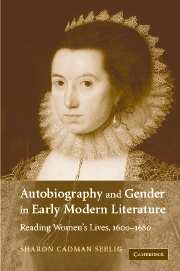Book contents
- Frontmatter
- Contents
- Preface
- Introduction: mapping the territory
- 1 Margaret Hoby: the stewardship of time
- 2 The construction of a life: the diaries of Anne Clifford
- 3 Pygmalion's image: the lives of Lucy Hutchinson
- 4 Ann Fanshawe: private historian
- 5 Romance and respectability: the autobiography of Anne Halkett
- 6 Margaret Cavendish: shy person to Blazing Empress
- Conclusion: “The Life of Me”
- Notes
- Bibliography
- Index
6 - Margaret Cavendish: shy person to Blazing Empress
Published online by Cambridge University Press: 22 September 2009
- Frontmatter
- Contents
- Preface
- Introduction: mapping the territory
- 1 Margaret Hoby: the stewardship of time
- 2 The construction of a life: the diaries of Anne Clifford
- 3 Pygmalion's image: the lives of Lucy Hutchinson
- 4 Ann Fanshawe: private historian
- 5 Romance and respectability: the autobiography of Anne Halkett
- 6 Margaret Cavendish: shy person to Blazing Empress
- Conclusion: “The Life of Me”
- Notes
- Bibliography
- Index
Summary
The women writers I've been discussing represent a developing sequence of strategies of self-representation: from Margaret Hoby, whose character and daily activities are glimpsed through the record of her devotional life; to Anne Clifford, whose strength emerges in the struggle to maintain property, custody of her daughter, and a sense of herself, expressed first in brief diary entries and later in more connected and controlling narrative accounts; to Lucy Hutchinson and Ann Fanshawe, who, though casting themselves within a larger narrative in which their husbands figure prominently, nevertheless manage to occupy important and central roles. Anne Halkett comes closest of all to a coherently shaped narrative of her own life, one that uses motifs associated with more fully developed narrative forms – the novel and the romance – and sometimes achieves a striking degree of psychological realism or dramatic flair. The earlier texts, those of Hoby and Clifford, depend more clearly on devices of time, being written in the form of a daily record, or establishing connections through momentous anniversaries or in significant places. The subsequent texts – of Hutchinson, Halkett, and Fanshawe – rely more heavily on motifs associated with character, judgment, or action. Using forms that are deeply connected to the writers' process of understanding, these accounts present the influence of providence or bear the marks of romance, develop the argument for integrity or family pride.
- Type
- Chapter
- Information
- Autobiography and Gender in Early Modern LiteratureReading Women's Lives, 1600–1680, pp. 131 - 153Publisher: Cambridge University PressPrint publication year: 2006

